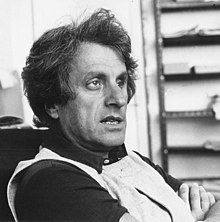Rebonds (Xenakis)
| Rebonds | |
|---|---|
| by Iannis Xenakis | |

Iannis Xenakis c. 1970
|
|
| Period | Contemporary music |
| Composed | 1987-1989 |
| Dedication | Silvio Gualda |
| Duration | 12 minutes |
| Scoring | Percussion |
Rebonds is a composition for solo percussion by Greek composer Iannis Xenakis. It was composed between 1987 and 1989 and, together with Psappha, is one of the two compositions for solo percussion by Xenakis.
Rebonds was written for percussionist Sylvio Gualda, for whom Xenakis had also dedicated other chamber compositions, such as Komboï. It was later published by Éditions Salabert, in an edition revised by Patrick Butin.
Some could argue that Xenakis composed this piece to revolutionize the idea of a solo percussion piece. Many different elements of this piece, such as the ideas of indeterminancy, and the fact that the piece sounds as if more than one person is playing, creates a new sound for solo percussionists.
The composition is in two autonomous movements, named A and B, which take up to 12–13 minutes to perform. The first movement uses only skins, with two bongos, three tom-toms, and two bass drums. The second movement, however, uses two bongos, one tumba, one tom-tom, one bass drum, and a set of five wood blocks or wooden slats. According to Xenakis, the order of the composition is not fixed: either first A, then B, or vice versa, but both movements should be performed attacca.
In Conversations with Iannis Xenakis, Xenakis clarifies that both movements are "to be played as written, at the written tempos, with all the written notes", which, paradoxically, leads performers to make relatively personal interpretations of the piece, given that several fragments of it are technically nearly impossible to perform. Some thematic structures were featured in the contemporaneous Okho for three djembés.
There are more choices for the performer than just the form. The performer can choose the tuning of the drums (since all drums can be tuned by tightening or loosening the heads), what sticks they use (there are many options of sticks, such as hard or soft mallets, or even different sizes of drum sticks), and which rhythms they play. Many of the different rhythms of the piece are almost impossible, so the performer must pick what notes they want to play, and which notes they have to skip over. These elements of indeterminacy all add to the idea that Xenakis revolutionized the solo percussion piece.
...
Wikipedia
